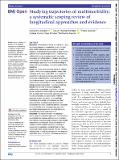Files in this item
Studying trajectories of multimorbidity : a systematic scoping review of longitudinal approaches and evidence
Item metadata
| dc.contributor.author | Cezard, Genevieve | |
| dc.contributor.author | McHale, Calum Thomas | |
| dc.contributor.author | Sullivan, Frank | |
| dc.contributor.author | Bowles, Juliana Kuster Filipe | |
| dc.contributor.author | Keenan, Katherine | |
| dc.date.accessioned | 2021-11-24T10:30:04Z | |
| dc.date.available | 2021-11-24T10:30:04Z | |
| dc.date.issued | 2021-11-22 | |
| dc.identifier | 276830553 | |
| dc.identifier | 763d2a8f-b89f-48f1-be2f-252547050427 | |
| dc.identifier | 85120375991 | |
| dc.identifier | 000721849100004 | |
| dc.identifier.citation | Cezard , G , McHale , C T , Sullivan , F , Bowles , J K F & Keenan , K 2021 , ' Studying trajectories of multimorbidity : a systematic scoping review of longitudinal approaches and evidence ' , BMJ Open , vol. 11 , no. 11 , e048485 . https://doi.org/10.1136/bmjopen-2020-048485 | en |
| dc.identifier.issn | 2044-6055 | |
| dc.identifier.other | RIS: urn:F90E04CFDD529E2E3D5A2FCB0EEF61AD | |
| dc.identifier.other | ORCID: /0000-0002-5918-9114/work/103865258 | |
| dc.identifier.other | ORCID: /0000-0002-9274-7261/work/103865690 | |
| dc.identifier.other | ORCID: /0000-0002-3011-7416/work/103865883 | |
| dc.identifier.other | ORCID: /0000-0002-9670-1607/work/103865928 | |
| dc.identifier.other | ORCID: /0000-0002-6623-4964/work/103865742 | |
| dc.identifier.uri | https://hdl.handle.net/10023/24388 | |
| dc.description | This work was supported by the Academy of Medical Sciences, the Wellcome Trust, the Government Department of Business, Energy and Industrial Strategy, the British Heart Foundation Diabetes UK, and the Global Challenges Research Fund (Grant number SBF004\1093 awarded to KK). | en |
| dc.description.abstract | Objectives Multimorbidity—the co-occurrence of at least two chronic diseases in an individual—is an important public health challenge in ageing societies. The vast majority of multimorbidity research takes a cross-sectional approach, but longitudinal approaches to understanding multimorbidity are an emerging research area, being encouraged by multiple funders. To support development in this research area, the aim of this study is to scope the methodological approaches and substantive findings of studies that have investigated longitudinal multimorbidity trajectories. Design We conducted a systematic search for relevant studies in four online databases (Medline, Scopus, Web of Science and Embase) in May 2020 using predefined search terms and inclusion and exclusion criteria. The search was complemented by searching reference lists of relevant papers. From the selected studies, we systematically extracted data on study methodology and findings and summarised them in a narrative synthesis. Results We identified 35 studies investigating multimorbidity longitudinally, all published in the last decade, and predominantly in high-income countries from the Global North. Longitudinal approaches employed included constructing change variables, multilevel regression analysis (eg, growth curve modelling), longitudinal group-based methodologies (eg, latent class modelling), analysing disease transitions and visualisation techniques. Commonly identified risk factors for multimorbidity onset and progression were older age, higher socioeconomic and area-level deprivation, overweight and poorer health behaviours. Conclusion The nascent research area employs a diverse range of longitudinal approaches that characterise accumulation and disease combinations and to a lesser extent disease sequencing and progression. Gaps include understanding the long-term, life course determinants of different multimorbidity trajectories, and doing so across diverse populations, including those from low-income and middle-income countries. This can provide a detailed picture of morbidity development, with important implications from a clinical and intervention perspective. | |
| dc.format.extent | 653313 | |
| dc.language.iso | eng | |
| dc.relation.ispartof | BMJ Open | en |
| dc.subject | RA Public aspects of medicine | en |
| dc.subject | 3rd-DAS | en |
| dc.subject | SDG 3 - Good Health and Well-being | en |
| dc.subject.lcc | RA | en |
| dc.title | Studying trajectories of multimorbidity : a systematic scoping review of longitudinal approaches and evidence | en |
| dc.type | Journal article | en |
| dc.contributor.sponsor | Academy of Medical Sciences | en |
| dc.contributor.institution | University of St Andrews. School of Geography & Sustainable Development | en |
| dc.contributor.institution | University of St Andrews. School of Medicine | en |
| dc.contributor.institution | University of St Andrews. Population and Behavioural Science Division | en |
| dc.contributor.institution | University of St Andrews. Sir James Mackenzie Institute for Early Diagnosis | en |
| dc.contributor.institution | University of St Andrews. School of Computer Science | en |
| dc.contributor.institution | University of St Andrews. Population and Health Research | en |
| dc.contributor.institution | University of St Andrews. Geographies of Sustainability, Society, Inequalities and Possibilities | en |
| dc.identifier.doi | https://doi.org/10.1136/bmjopen-2020-048485 | |
| dc.description.status | Peer reviewed | en |
| dc.identifier.grantnumber | SBF004\1093 | en |
This item appears in the following Collection(s)
Items in the St Andrews Research Repository are protected by copyright, with all rights reserved, unless otherwise indicated.

